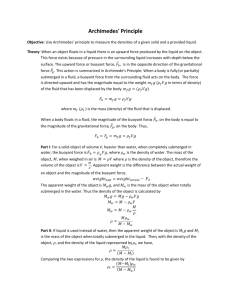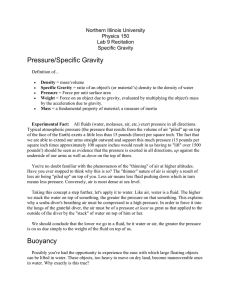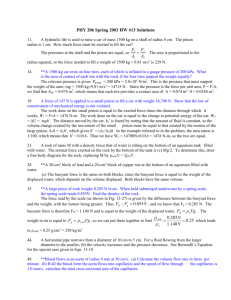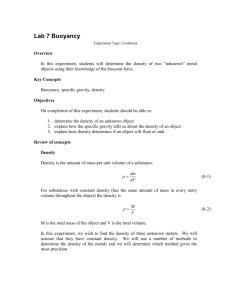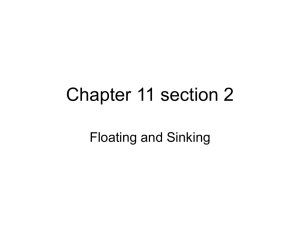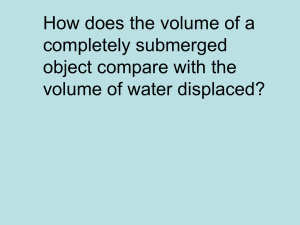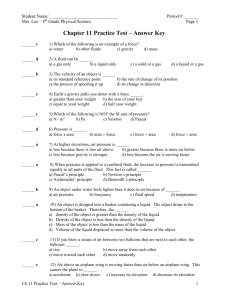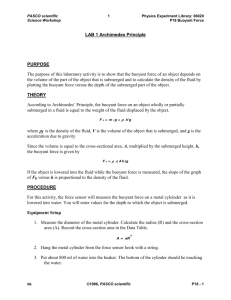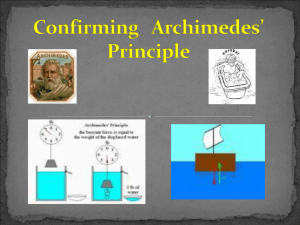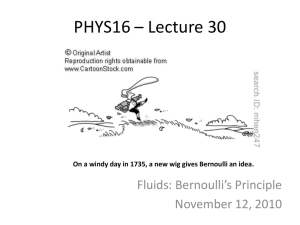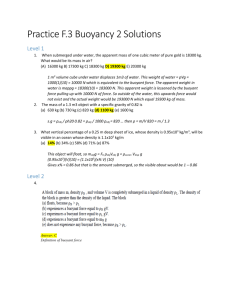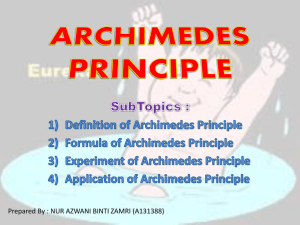In Class Notes - Hydrostatics and Buoyancy
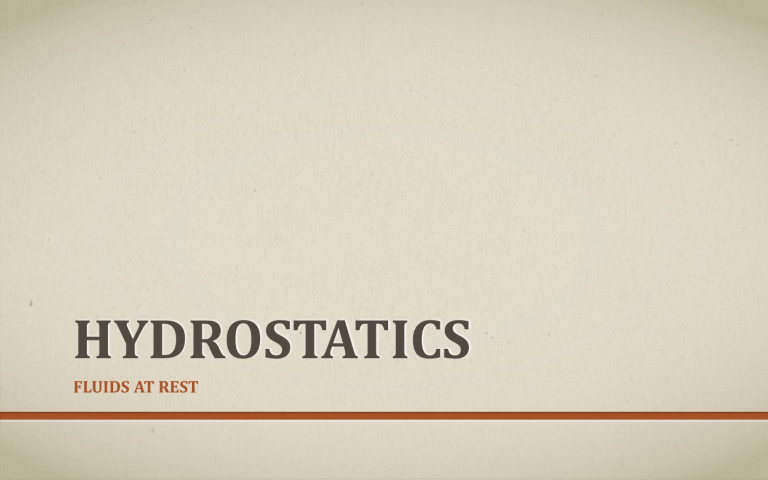
HYDROSTATICS
FLUIDS AT REST
OBJECTIVES
1.
Define and apply the concepts of density and fluid pressure to solve physical problems.
2.
Define and apply concepts of absolute , gauge , and atmospheric pressures.
3.
State Pascal ’ s law and apply for input and output pressures.
4.
State and apply Archimedes ’ Principle to solve physical problems.
WHAT IS A FLUID?
DENSITY VS. MASS DENSITY
What is Density?
• density is a measure of a quantity of a substance in a given space
How is it different than Mass Density?
• mass density measures the mass of a substance in a given space ~ we will use this!
COMMON DENSITY’S
SPECIFIC GRAVITY
The specific gravity r r of a material is the ratio of its density to the density of water (1000 kg/m3). No Units!
Why would know specific gravity of a substance be a useful measurement?
r
x
1000 kg/m
3
Steel (7800 kg/m 3 )
Brass (8700 kg/m 3 )
Wood (500 kg/m 3 )
r
= 7.80
r
= 8.70
r
= 0.500
QUESTION
Six objects (A-F) are in a liquid, as shown. None of them are moving. Arrange them in order of density, from lowest to highest.
ANSWER
Full answer to the question: B, D, A, F, E, C.
The more of an object's volume is above the water surface, the less dense it is. Object B must therefore be the least dense, followed by D, A, and
F. Object E is next, because it is neutrally buoyant and equal in density to the liquid. Object C is negatively buoyant because it is more dense than the fluid.
QUESTION:
Why do things feel lighter in water than they do in air?
ANSWER: The reason is that a fluid exerts an upward force on objects that are partially or completely submerged in it. This upward force is called a buoyant force.
BUOYANT FORCE
1.
Acts in the opposite Direction of the Force of gravity
2.
Net force acting on an object is therefore ALWAYS smaller than zero
3.
The weight of an object in water is it’s apparent weight
4.
If the objects Specific Gravity is less than 1, the buoyant force is larger
than gravity and therefore an object floats!
ARCHIMEDES PRINCIPLE
Any object completely or partially submerged in a fluid experiences an upward buoyant force equal in magnitude to the weight of the fluid displaced by the object.
CONFUSING!
SINKING VS. FLOATING
QUESTION
A cube of steel that measures 5.0 cm on each side is immersed in water. The density of steel is 9.0 x 10 3 kg/m 3 . The density of water is 1.0 x 10 3 kg/m 3 . What is the….
(a) buoyant force acting on the cube? and…
(b) its apparent weight?
ANSWER:
(a) Find the buoyant force.
The volume of the cube is:
(b) Find the apparent weight.
The weight of the cube is:
Now we can plug and chug:
To find the apparent weight we use this equation:
F
A
=
F
W
-
F
B
=
110 N
-
12 N
=
98 N
Extra Questions:
1.
A 2.8 kg rectangular air mattress is 2.00 m long, 0.500 m wide, and 0.100 m thick. What mass can it support in water before sinking?
2.
A ferry boat is 4.0 m wide and 6.0 m long. When a truck pulls onto it, the boat sinks 4.00 cm in the water. What is the weight of the truck?
3.
An empty rubber balloon has a mass of 0.0120 kg. The balloon is filled with helium at 0°C, 1 atm pressure, and a density of 0.179 kg/m 3 . The filled balloon has a radius of
0.500 m. a.
What is the magnitude of the buoyant force acting on the balloon? (Hint: See Table 1 for the density of air.) b.
What is the magnitude of the net force acting on the balloon?
ANSWERS
1.
97kg
2.
9.4×10 3 N
3.
a. 6.63 N b. 5.59 N
PRESSURE
What is pressure?
Pressure is a measure of how much force is applied over a given area.
PASCAL’S PRINCIPAL/PASCAL’S LAW
Pressure applied to a fluid in a closed container is transmitted equally to every point of the fluid and to the walls of the container.
HYDRAULIC LIFT
The key: Pressure is equal at both points of the lift
QUESTION
The small piston of a hydraulic lift has an area of 0.20 m 2 . A car weighing
1.20 x 10 4 N sits on a rack mounted on the large piston. The large piston has an area of 0.90 m 2 . How large a force must be applied to the small piston to support the car?
ANS: F
1
= 2.7 x 10 3 N
DEPTH
Why are submarine hulls made of thick layers of titanium or steel?
Pressure in fluids increases with depth! We can derive this from our pressure formula.
Gauge Pressure:
FLUID PRESSURE AS A FUNCTION OF DEPTH
Atmospheric Pressure: P
0
= 1.0 x 10 5 Pa
CONNECTING BUOYANT FORCE TO PRESSURE
Explain why the force at the bottom of the object is greater than at the top of the object.
ANS: at greater depth the pressure is great resulting in a great force on the bottom than the top
QUESTION 1:
A diver is located 20 m below the surface of a lake (ρ = 1000 kg/m 3 ).
What is the gauge pressure due to the water?
ΔP = 196 kPa
What is the absolute pressure?
ΔP = 296 kPa h
ρ = 1000 kg/m 3
QUESTION 2:
A 2-kg brass block is attached to a string and submerged underwater. Find the buoyant force and the tension in the rope. Include a Force diagram!
Density = 8700 kg/m 3
F
B
+ T = mg F
B
= ρ w gV w
T
F
B
= 2.25 N T = 17.3 N
F
B
= gV
Force diagram mg
